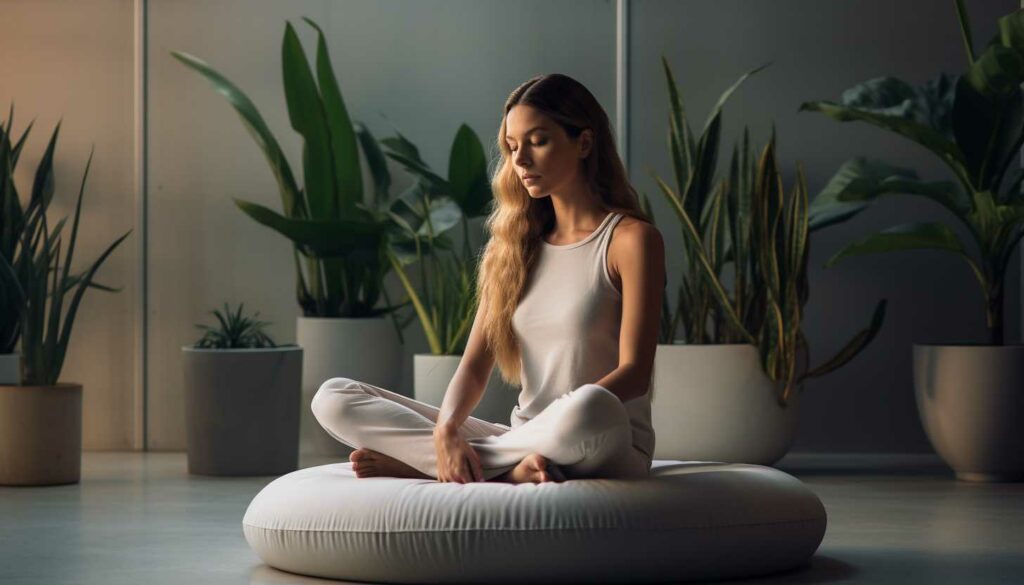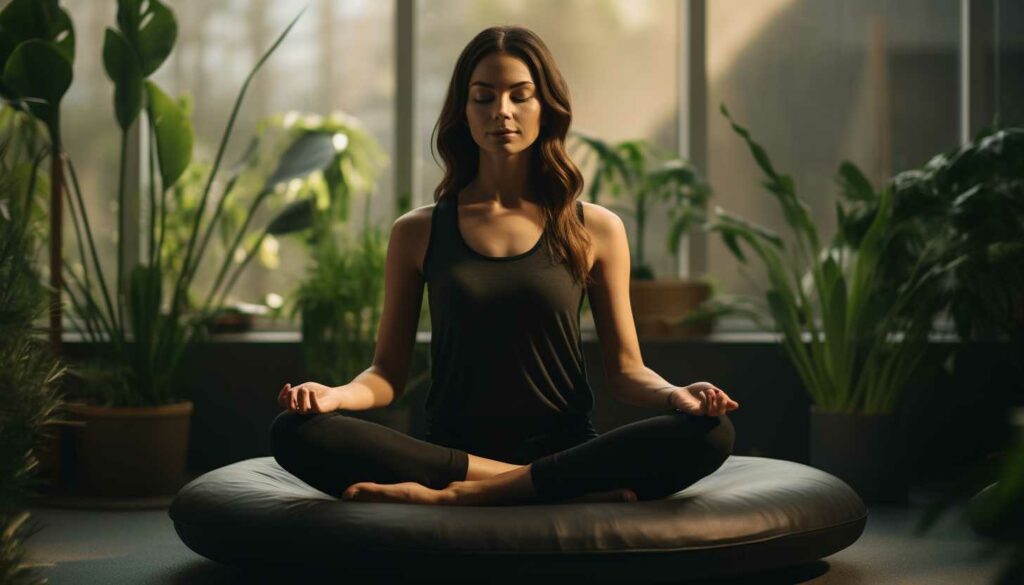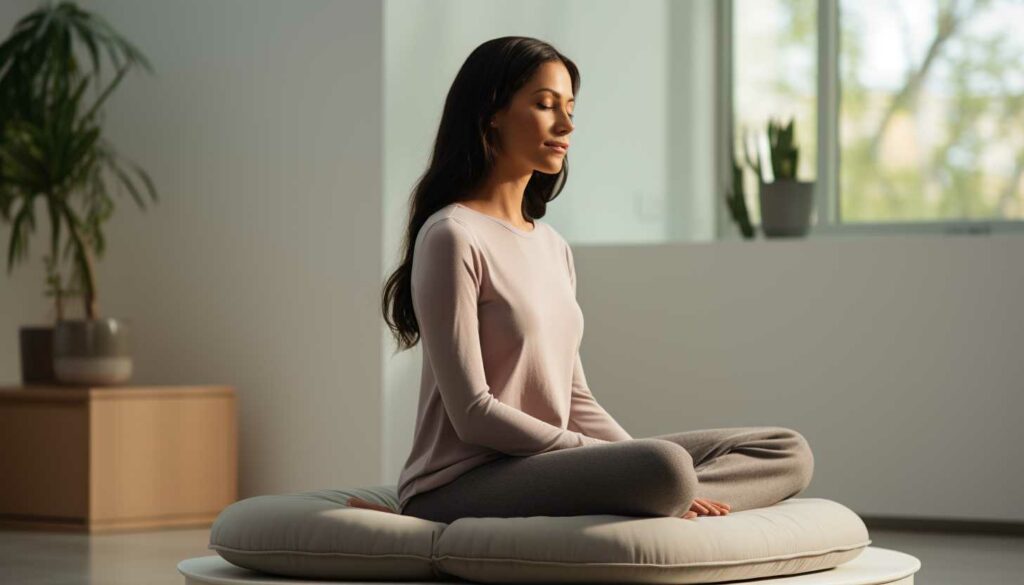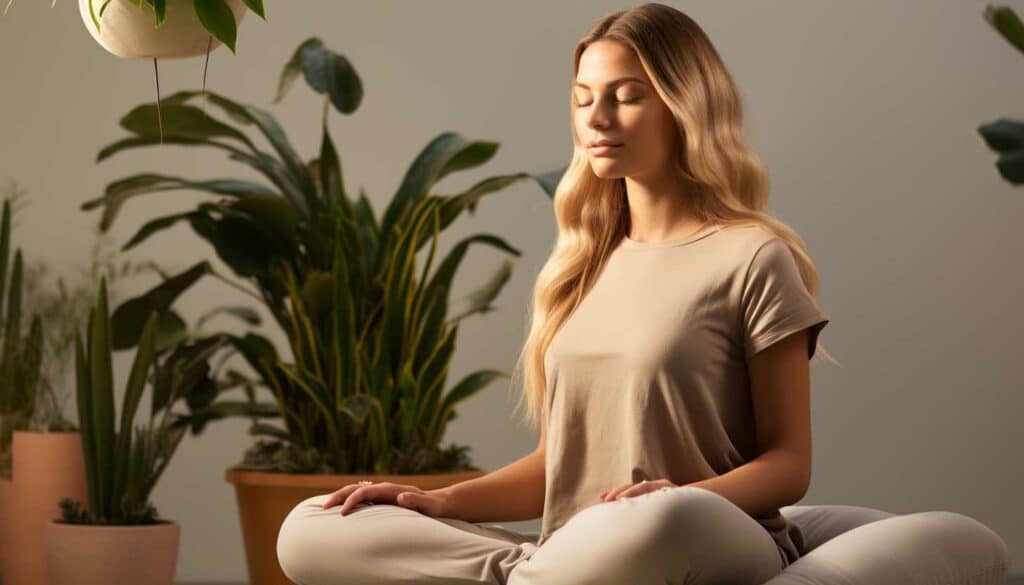Struggling with discomfort or distractions during your meditation routine? Using a meditation cushion could be the key to a deeper, more effective practice. This article will guide you through how to use this essential tool, providing tips and explaining numerous benefits of incorporating it into your daily routine.
Ready to take your meditation experience up a notch? Let’s dive in!
Starting your spiritual journey? Give this unique guided meditation a try:

Unleash Your True Potential!
Explore the world of meditation with our powerful guided sessions crafted to bring peace and strength to your spirit.
But first, let’s ensure our sessions are the perfect fit for you.
Take our short quiz to find out!
Table of contents
Key Takeaways
- Using a meditation cushion can improve your posture, comfort, and focus during meditation sessions.
- Different meditation cushions are available, such as round zafus and rectangular cushions, so choose one that suits your needs and preferences.
- If a traditional cushion doesn’t work for you, consider alternatives like meditation benches or folded blankets.
- Using a meditation cushion can have various benefits including improved posture, enhanced comfort and focus, strengthened mind-body connection, promotion of regular practice, and mindfulness in daily life.
How to Use a Meditation Cushion: Step-By-Step
Adjusting your cushion for maximum comfort is the first step to using it effectively. Meditation cushion comes in many variety. These steps are for a flat meditation cushion that comes with a pillow called zafu, along with a cushion known as zabuton. Other types of meditation cushions also use a similar sitting approach.

- Start by preparing your meditation space. Lay out a zabuton, a flat and comfortable mat designed for meditation, on the floor.
- Next, take the zafu, a round meditation cushion, and position it on top of the zabuton. Ensure that it’s centered and aligned with your intended meditation space.
- Sit down on the zafu cushion in a way that allows you to be comfortable and maintain an upright posture. Position your hips towards the center of the zafu and find a spot that feels balanced and stable.
- To maintain proper posture, sit with your spine straight but not rigid. Your back should be comfortably aligned, and your shoulders relaxed.
- Choose a suitable cross-legged pose or opt for the easy pose (also known as the Burmese position) by crossing your legs, placing one foot in front of the other with your knees touching the floor. Ensure that your feet are positioned close to your body.
- Place your hands on your lap, with the palms facing upwards. The right hand can rest on top of the left, and your thumbs can lightly touch, forming a small oval shape.
- Now, gently rest your feet on the zabuton, ensuring that they are comfortable and grounded.
- With your posture settled and your body relaxed, you’re ready to begin your meditation session. Close your eyes if you prefer, take a few deep breaths, and allow your mind to focus inward as you meditate.
- During meditation, remain still and centered on your cushion, maintaining a calm and relaxed state of mind.
- Meditate for your desired duration, and when you’re ready to conclude your practice, slowly open your eyes, take a few deep breaths, and gently stand up.
Adjustments for comfort
You want a meditation cushion that feels just right. If you are too high, try removing some stuffing. Add more if you’re sinking down too much. Make sure your knees can touch the floor for balance.
Move around until it’s comfy. You should not feel any pain while sitting on it for long hours.
Troubleshooting common issues
You might face some problems with your meditation cushion. Don’t worry, we have solutions! If the cushion is too high, try spreading out the filling. Still too hard? Take out some stuffing.
Does your back ache when you sit on it? Try to move around a little. Make sure your hips are higher than your knees. This makes sitting longer easier and more comfortable for you!
Types of meditation cushions
You can find many kinds of cushions for meditation. Here are the most common ones:

Round Zafu: This is a classic cushion shape. It helps you sit in a cross-legged pose.
No products found.
Crescents: These have a curved shape to support your thighs.
No products found.
Rectangular Cushions: These offer good firmness and height.
No products found.
Inflatable Cushions: They are great if you travel often. You can take them anywhere.
No products found.
Meditation Benches: Some people like these better than cushions.
No products found.
Roll Pillows: These offer support for other body parts, like the back or knees.
No products found.
Back Support Pillows: They help keep your spine straight.
No products found.
Different Ways to Use a Meditation Cushion
There are several different ways you can use a meditation cushion to enhance your practice.
Kneeling with support
Kneeling with support is one way to use a meditation cushion. To do this, start by kneeling on the cushion with your knees hip-width apart. Place the support underneath your buttocks or between your feet to provide stability and comfort.
This position allows you to sit upright while taking some of the pressure off your legs and joints. It can be especially helpful if you have knee or ankle issues. Kneeling with support encourages proper alignment and helps maintain focus during meditation sessions.
Various cross-legged positions
There are different cross-legged positions you can try while using a meditation cushion. One option is the classic “Easy Pose” with both legs crossed in front of you, resting on the cushion.
Another option is the “Half Lotus,” where one foot rests on top of opposite thigh while the other leg remains folded underneath. You can also try the “Full Lotus,” where both feet rest on top of opposite thighs.
These positions help to keep your spine straight and promote stability during your meditation practice. Experiment with these different positions to find what feels most comfortable for you and allows for deep relaxation and focus.
Arching back for chest opening

Sit on your meditation cushion with an upright posture, and place your hands on your thighs. Start by taking a deep breath in, and as you exhale, gently arch your back backwards. This movement opens up the chest area, allowing for deeper breathing and a sense of expansion.
Relax your shoulders and keep the neck long as you hold this position for a few breaths. This chest opening stretch can help release tension in the upper body and promote relaxation during meditation.

Unleash Your True Potential!
Explore the world of meditation with our powerful guided sessions crafted to bring peace and strength to your spirit.
But first, let’s ensure our sessions are the perfect fit for you.
Take our short quiz to find out!
Child’s pose
Child’s pose is a restful and comforting position that can be done with the help of a meditation cushion. To do this pose, you simply sit on your heels and then bend forward, resting your torso on the cushion.
This allows for deep relaxation of the back muscles. It also helps to release tension in the shoulders and neck. Child’s pose is especially great for those who find sitting cross-legged uncomfortable as it provides an alternative posture while still allowing for a focused and meditative state.
It also helps to promote feelings of safety, grounding, and surrender during your meditation practice. So if cross-legged positions don’t work for you, try child’s pose with a meditation cushion instead!
Tips for Using a Meditation Cushion

Integrate your meditation cushion into your practice, choose the right cushion for you, and consider alternatives to traditional cushions.
Integrating into your practice
To integrate a meditation cushion into your practice, start by finding a nice comfortable and quiet space where you can sit undisturbed. Begin with shorter meditation sessions and gradually increase the time as you become more familiar with using the cushion.
Experiment with different positions, such as kneeling or sitting cross-legged, to find what works best for you.
As you use the cushion regularly, it will become an essential part of your meditation routine. Try incorporating it into different aspects of your day-to-day life, like using it for short mindfulness breaks during work or before going to bed.
Choosing the right cushion
To choose the right meditation cushion, consider your comfort and personal preferences. Look for cushions that provide enough support and stability for your body. It’s also important to consider the shape and size of the meditation cushion, as well as materials used.
Some popular options include zafu cushions (round with pleats) or zabuton cushions (rectangular). You might also want to try different fillings such as buckwheat hulls or foam to find what feels best for you.
No products found.
Experiment with different cushions to find one that helps you sit comfortably during your meditation practice.
Alternatives to traditional cushions
If a traditional meditation cushion doesn’t feel comfortable or suitable for you, here are some alternative options to consider:
- Meditation Bench: A meditation bench is a small stool that allows you to sit in a kneeling position. It helps relieve pressure on the ankles and knees, making it a good choice for those with joint pain or flexibility issues.
- Zafu Pillow: Similar to a traditional cushion, a zafu pillow offers more height and support. It is typically filled with buckwheat hulls or kapok fibers, providing firmness and stability during meditation.
- Yoga Bolster: A yoga bolster is a long, cylindrical pillow that can be used as additional support during meditation. It can be placed under your knees, back, or hips to help maintain proper alignment and reduce strain.
- Folded Blanket: If you don’t have access to a dedicated meditation cushion, you can fold a blanket to create a makeshift cushion. Experiment with different thicknesses until you find the right level of comfort and support.
- Chair: If sitting on the floor isn’t an option for you due to physical limitations or discomfort, using a chair can be an excellent alternative. Choose a chair without arms and sit towards the front edge with your feet flat on the ground.
No products found.
Benefits of Using a Meditation Cushion
Using a meditation cushion can offer various benefits such as improved posture, enhanced comfort and focus, a stronger mind-body connection, the promotion of a regular meditation practice, and mindfulness throughout daily life.
Improved posture
Using a meditation cushion can help improve your posture while meditating. When you sit on a cushion, it elevates your hips slightly above your knees, which naturally helps to align your spine.
This straightens your back and shoulders, allowing for better alignment of the entire body. With improved posture, you’ll feel more grounded and stable during meditation, preventing slouching or discomfort in the long run.
By maintaining good posture on a meditation cushion, you can experience deeper relaxation and focus during your practice. So whether you’re a beginner or an experienced meditator, using a cushion can greatly benefit your overall posture and enhance your meditation experience.
Enhanced comfort and focus
Using a meditation cushion can enhance your comfort and focus during your practice. The cushion provides support for your body, allowing you to sit in a comfortable posture for a nice period of time without feeling discomfort or pain.
This increased comfort helps you to stay focused and present during meditation sessions, as you are not constantly shifting or adjusting due to any discomfort. By eliminating physical distractions, the cushion enables you to fully immerse yourself in the practice, creating a more profound meditative experience.
With enhanced comfort and focus, you can dive deeper into your mindfulness journey and reap the benefits that come with regular meditation practice.
Mind-body connection
Using a meditation cushion can help strengthen the mind-body connection. When you sit on a cushion, it supports your body and aligns your spine, allowing for better posture and comfort during meditation.
This alignment helps to relax tense muscles and release physical tension, which in turn can calm the mind. As you focus on your breath and sensations in your body while meditating on a cushion, you become more aware of the present moment.
This increased mindfulness strengthens the connection between your mind and body, promoting overall well-being and deepening your meditation practice. So, by using a meditation cushion regularly, you can enhance both physical and mental relaxation.
Promotes a regular meditation practice
Using a meditation cushion can help promote a regular meditation practice. By providing support and comfort, the cushion creates an inviting space for you to sit and meditate regularly.
Having a dedicated cushion can also serve as a visual reminder of your meditation practice, making it more likely that you’ll incorporate it into your daily routine. Additionally, using a cushion allows you to establish a consistent posture that promotes focus and relaxation during meditation.
With continued use, the combination of physical support and mental discipline offered by the cushion can help cultivate mindfulness throughout your daily life.
Mindfulness throughout daily life
In addition to enhancing your meditation practice, using a meditation cushion can also promote mindfulness in your daily life. When you regularly sit on a cushion, it serves as a reminder to be present and attentive throughout the day.
It encourages you to bring awareness to your body and breath, even when you’re not meditating. By cultivating this sense of mindfulness outside of your formal practice, you become more grounded and focused in each moment.
Whether you’re sitting at work, eating a meal, or spending time with loved ones, the cushion becomes a symbol of staying connected to the present moment and living with intention.
Conclusion
Using a meditation cushion can greatly enhance your meditation practice. By following the step-by-step instructions and making adjustments for comfort, you’ll be able to find the perfect position that works for you.
Whether you’re kneeling with support or sitting in various cross-legged positions, the cushion provides stability and promotes proper posture. Not only does it improve focus and mindfulness, but it also encourages a regular meditation routine.
So go ahead, grab your cushion, and start enjoying all the benefits a meditation cushion has to offer!
FAQs
What is a meditation cusion?
A meditation cushion is a soft seat for comfort during mediation. To use it, you sit on it in an upright position.
Is there a right way to sit on a meditation pillow?
Yes, the best way to sit on your meditation pillow is with your legs crossed and back straight.
Can anyone show me how to use my new meditation cushion?
You can find easy tips online or ask someone who meditates to teach you how to sit on your meditation cushion correctly.
Are there benefits of using a meditation cushion during practice?
Definitely! A good sitting posture helps focus better and the softness of the pillow makes mediation more comfortable.










